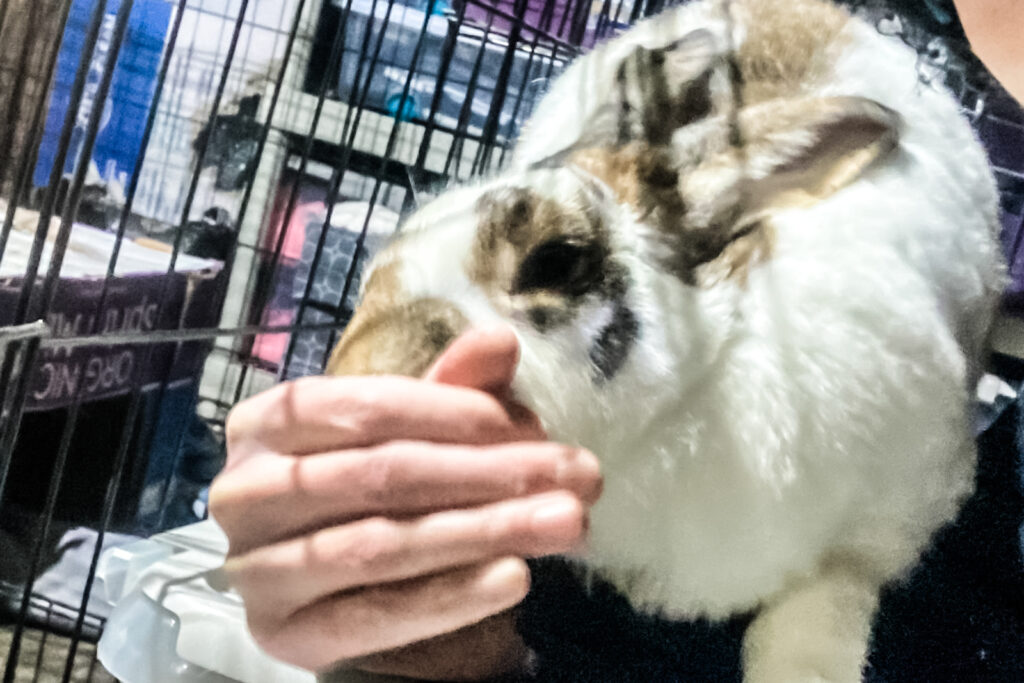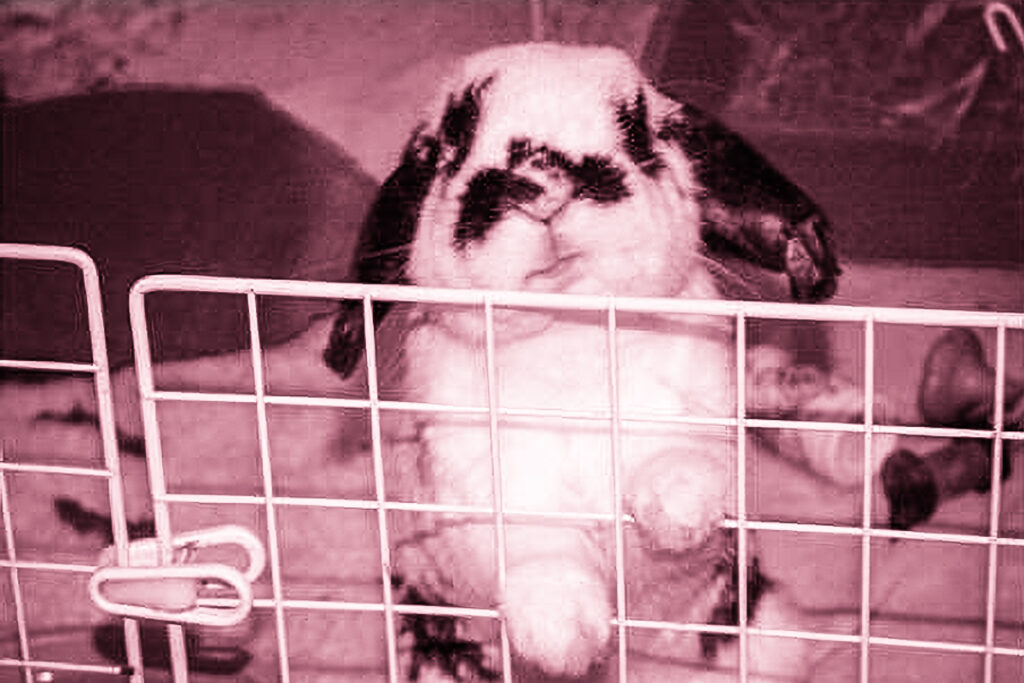PEOPLE ARE OFTEN shocked the first time they see a rabbit display anger. Bunnies, after all, are supposed to be timid and sweet, not outspoken and nasty, and the sudden appearance of sharp teeth and raking claws can be disarming. But whether your rabbit is nipping the hand that feeds him, chasing you across the room, or latching his teeth into your calf, it’s not unusual and it’s not hopeless.
In fact, working with an aggressive or mean rabbit can be extremely rewarding. Aggressive rabbits are often very intelligent animals who are just trying to express themselves. Once they’re given some respect and some ground rules, that expression can turn to boundless energy, enthusiasm, and affection.
Ballistic Bunnies 101
Aggressive rabbits can be scary. Rabbits bite hard, kick hard, and move fast, so it’s not unusual for owners to get intimated, or start dreaming of dumping their rabbit at the pound. So before you even approach this rabbit, convince yourself of the following principles:
Rabbits aren’t born mean
Ninety-nine percent of aggressive rabbits have a behavioral problem, not a genetic one. Behavior can be changed, so give your bunny a chance. The biggest behavior change happens at 4 months, and this is the time to visit your rabbit veterinarian to talk about spay and neuter. There is very little chance of having a calm, non-biting/scratching bunny after 4 months of age if not soon fixed. Think of the human teenager. Your rabbit is growing up; hormones are in control, and your rabbit is changing.
Your rabbit doesn’t hate you
There may be a slight chance that your rabbit has taken a personal dislike to one person. More likely, she’s afraid you’re going to hurt her. Nevertheless…
You’re the only one who can solve the problem
Your rabbit won’t wake up one day and say, “Gee, maybe I should be nicer to Jane.” It’s the humans who have to figure out what’s wrong and initiate new ways of interacting.
You must Never hit a rabbit
Some people try to “teach” their bunnies not to bite by swatting their noses or even hitting them with newspapers. This will only aggravate the problem tenfold. Your hands MUST be seen as only a source of affection, bringing hay and food, and petting/love. Never, and I must repeat, NEVER hit or tap your rabbit for biting. He/she will never forget, and this will make things so much worse. You need to reassure your rabbit that her environment is safe and you are there to help. If you can train yourself not to flinch when he/she pounces or attacks, that will teach your rabbit, “Hey, this doesn’t work.” Using a high-pitched “eeeekk” sound will let him know it hurt, and this is how they tell each other about pain. Spend several minutes a day, as much as you can, petting your rabbit from the top of the head back, slowly.
Common Aggression Scenarios
The first step in helping an aggressive rabbit is figuring out what’s making him tick. First be sure your rabbit is healthy. Often rabbits will bite out of pain, so a trip to a good rabbit vet will look for tooth problems, pain, etc. This is often missed.
The following scenarios, all taken from real life, illustrate the basic causes of aggression and some easy ways to solve it. (Names have been changed to protect the reformed)
“Every time I walk in the room, Netty circles my feet and bites my ankles. Does she want something from me?”
She does–and you can’t give it to her. Circling, mounting, and biting are classic signs of a sexually frustrated bunny. It may be cute at first, but it can develop into a pretty nasty habit. Neutering males and spaying females can dramatically reduce aggressive behavior. In the meantime, try the suggestions listed below to protect you and your loved ones.

“When I put my hand down for my new rabbit, Jaws, to sniff she lunges at it. Doesn’t she like the way I smell?”
It isn’t the smell, it’s the motion and the position. Although rabbits have great long-distance eyesight, their near-distance vision isn’t so great. A human hand in front a rabbit’s face can be very startling, and a rabbit may lunge defensively at the perceived threat. They see very well far (the bird in the sky they may be looking at when you think they are looking at you). Their life depends on seeing the predators far, so the near vision is not that good. Put a hand in front of your face. Like a horse, this is how your rabbit sees you up close. He doesn’t very well–especially in front!
This is not to say that smell does not affect a rabbit; it does. Many of us who work at animal shelters will notice lunges or bites from our sweet at-home rabbits when we come home, even after washing our hands. They have a keen sense of smell, so be aware it is a good idea to wash several times if handling other rabbits they are not used to, or dogs, cats, etc., and handle your home rabbit’s hay and bed before touching him/her.
One should also consider natural rabbit communication, and how a hand in front of your bunny’s face might be perceived as a message of hostility. In rabbit social situations, a dominant rabbit will often approach a subordinate from the front and place her face and body close to the subordinate’s nose. This “getting in her face” is one way rabbits maintain dominance, and the usual result is that the subordinate will give way and hop off to avoid a confrontation. But if the subordinate rabbit takes offense at this gesture, fur could fly! Thus, your rabbit may interpret your hand approaching her face as a sign of aggression on your part. She is doing no more than meeting your (perceived) aggression with a defensive lunge.
To break Jaws of her lunging habit, keep your hands above her head and away from her nose. When she looks aggravated, stroke her gently from above, avoiding her face except for her forehead, and speak in a soothing voice. Meeting aggression with more aggression will only escalate things. Positive reinforcement and understanding will go a long way towards getting your bunny to understand that you mean her no harm.
Some experienced rabbit people have found that carefully lifting an angry bunny and holding her with her spine against our breastbone–one hand around the rib cage, the other under the rump, all four feet and the mouth sticking straight out away from us, helps alleviate the anger and tells the bunny who is the “Top Bun” in a peaceful way. In this position, the rabbit feels totally secure, but is totally helpless and unable to bite.
“Attila is adorable. But when we reach into his cage to pull him out he bites our hands. What’s wrong?”
Rabbits can be very territorial. The first step to helping this rabbit is to stop dragging him out of his cage; he needs a place to call his own. Open the door and let him come and go on his own time. Wait until he’s out of his cage to clean it, change his water, or do other housekeeping chores. Do not clean a rabbit’s cage, and take out his boxes, toys with him in there. Would you like someone to come in and remove your iPad, television, bed? That is all the rabbit has–his cage. If need be, use a treat in a carrier, to entice him out.
After a few weeks, you can begin to try to touch him in his cage, but don’t grab him or mess with his stuff. Wear gloves so you don’t jerk your hand around, which may provoke him. Keep your hand above his head and then calmly and quickly bring it down to the top of his head. If he lets you touch his head, very softly stroke it. Tell him what a great big, brave, beautiful rabbit he is. Then let him alone until the next day, when you try the exercise again. Eventually he should associate your hand in the cage with a nice nose rub, not being grabbed.
“Sometimes when I try to stop Baby from eating the carpet, she nips my hands. Am I hurting her?”
No, you’re bugging her. Nipping is often a rabbit’s way of saying “back-off ” or “get out of my way” or “quit putting the wet stuff in my ears.” It’s understandable, but it’s not the greatest behavior for a house pet. Try pressing her head down, or also try squealing “EEEK!” when she nips, so she realizes she’s actually hurting you. Many rabbits will learn to nudge your hand instead, or simply hop away. You might also decide that little nips as communication are ok in your household.
“Piggy has started biting my hands when I put the food down. What’s her problem?”
Piggy is probably an enthusiastic eater. But she may not be sure you’re going to put the food down. If you’re putting the bowl down, make sure you put it right down—don’t make her beg or dance for it. Feed her on a regular schedule so she can count on chow at a certain time of day. And don’t overdo the snacks—it makes some rabbits expect a treat every time you walk in the room.
If she bites when you hand feed her, it’s probably because she can’t see what smells so good. Try feeding her larger treats (like Italian parsley or carrots, carrot tops) until she gets her aim down (some rabbits have to practice). You can also try feeding small treats, like raisins or a tiny piece of a banana, with wooden spoons or tongs. That way you can hold the treat steady for her without losing a thumb. Be sure to give you rabbit plenty of HAY……
Hay is extremely important to your rabbit’s digestion and to keep his teeth trimmed. Oat hay is a favorite and takes the longest to chew; also add Timothy, Orchard grass, etc., when you find out what he likes.
Extremely Aggressive Rabbits: Bunnies Who Run With the Wolves
Some rabbits are so “mean” they seem more like predators than prey. These are the rabbits who chase you across the room and up into chairs, who sink their teeth into your tender limbs and refuse to let go, or who growl at you when you approach. They’re the rabbits most likely to be dumped or put to sleep. Unfortunately, they’re often the ones who have suffered the most in life because somewhere along the line they learned that humans, or life itself, is not safe.
If your rabbit is neutered or spayed, there can be any number of reasons he’s aggressive. First you must give your rabbit time after spaying or neutering. It can take up to a MONTH for your rabbit’s hormones to settle down. It is by no means instantaneous, and they are sore for a few days after (especially females–give them a good 4 days without picking up or bothering them after spaying). If you just got a new rabbit, he may be stressed out by the move. His last owner may have frightened him somehow. He may have never had much contact with a human before. Or, if he used to be a hutch rabbit, the noises, smells, and sights of a house may be overwhelming him. One of the best things you can do for your relationship with this kind of rabbit is to protect yourself. Wear gloves, long sleeves, long pants, and real shoes when you’re around him. This will protect your flesh. It will also help you keep calm. If your skin is protected, you’re not as likely to jump, squeal or flail your arms, all of which might provoke or frighten him more.
Now start playing detective
Watch him closely to see what provokes him. It may be you’re touching anything in his view. It may be the movement of your legs when you walk . It may be a certain sound–like a rattling newspaper or the vacuum cleaner. It may be your reaching out to touch him or feed him. Whatever it is, don’t do it. He needs to learn that you’re not out to get him. One rabbit was frightened by sleeves, having been carried by young boys in coat pockets. You never know what happened to your rabbit before you got him.
Then turn on the charm
One of the key lessons that House Rabbit Society members have learned is that affection works wonders on psycho bunnies. Try acting like he’s the greatest thing that ever happened in your life, despite the bandages on your hand and the boots on your feet. Give him a big hello when you see him. Greet his every act of aggression with good humor too. When he charges your arm, say “why hello, you little pumpkin!” while calmly removing your arm from his reach. If he growls and thumps, say, “yes, you’re a BIG rabbit –I love that about you!” If he streaks across the room with murder in his eyes, simply say, “hey buddy, are you coming to see me?”
Bring joy to the engagement
You can ruffle his fur, sing a little song, say a little prayer, whatever it takes to greet his bad temper with joy, affection, and calmness. It takes courage, but if you have gloves and shoes on, you’re safe. If he looks like he’s going to bite, put your hand on his head, but continue to be cheerful. You can try saying EEK too–but be careful with this. Some nervous rabbits are provoked by a high-pitched squeal.
Rabbits think in patterns
Your job is to change the pattern, so he realizes that his approach provokes affection from you, not harm. Eventually he’ll associate you with kind words, nice pats, and enthusiasm for his particular personality. Don’t forget play time–toys, boxes, so he associates you with fun things!
Your bunny probably won’t change overnight
It can take weeks for a rabbit to learn to trust. But that’s what’s so rewarding, and so moving, about helping aggressive rabbits. You’re not just changing his behavior; you’re changing his perception of the world. As you do so, you’ll alleviate a lot of his suffering.
©Copyright Susan E. Davis. All Rights Reserved. Republished with the permission of the author.

